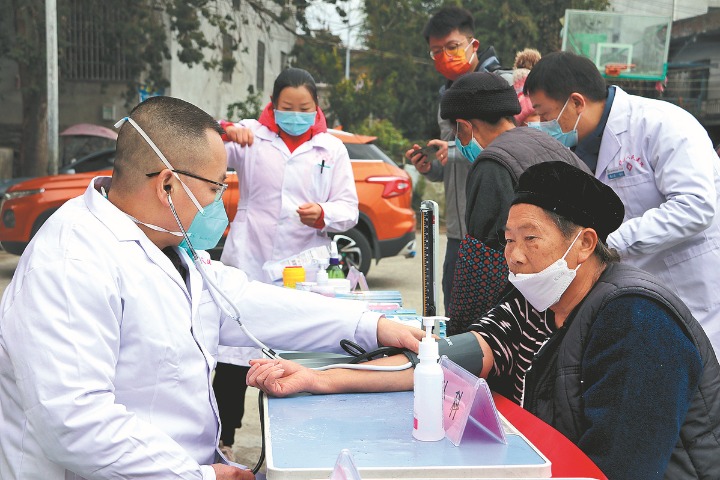Report: China's fight against COVID-19 (full text)
Glossary
Information release mechanism
Information, including daily updates of confirmed cases, suspected cases and response policies, has been revealed to the public in a timely, transparent and accurate manner through various means such as press conferences held by the State Council Information Office, the Joint Prevention and Control Mechanism of the State Council and local governments.
Avoid stigmatization
Viruses are a common challenge faced by the entire human race. The novel coronavirus was named SARS-CoV-2 and the relevant disease was named as COVID-19 according to international guidelines of avoiding association between viruses or infectious diseases with any geographic locations, cultures or groups of people.
Community-based epidemic prevention and control
Communities are on the front lines in prevention and control of the epidemic. Empowering communities to implement prevention and control measures is key to victory over COVID-19.
Report of the WHO-China Joint Mission on COVID-19
Twenty-five experts from eight countries and the World Health Organization started a nine-day mission in China on Feb 16. On Feb 29, the team released a report, which concluded China has rolled out "perhaps the most ambitious, agile and aggressive disease containment effort in history".
Lockdown of a city
Since there are not yet vaccines or targeted medications for the novel coronavirus, the lockdown of a region might be the most efficient way to prevent the virus from spreading.
High-, medium- and low-risk areas
Cities, counties and districts with no active cases or with no new infections in the past 14 days are categorized as low-risk regions; those with new infections in the past 14 days and fewer than 50 cumulative confirmed cases, or with over 50 cumulative confirmed cases but without a concentrated outbreak in the past 14 days are categorized as medium-risk regions; those with over 50 cumulative confirmed cases and a concentrated outbreak in the past 14 days are categorized as high-risk regions.
Self-quarantine
Since the outbreak, Chinese people have carried out self-quarantine, cut non-essential travel and stayed at home as much as possible to prevent cross-infection. Close contacts of confirmed cases should observe strict centralized quarantine or home quarantine for at least 14 days to see if there is any infection.
Social distancing
In public places, people should keep about 2 meters away from each other to protect themselves from possible infection. People are encouraged to wear a mask in public and avoid crowds or meal gatherings.
Health QR code
Based on information people voluntarily offer, a mobile app could generate a health QR code with different colors: Green code means little chance of having been infected, while holders of yellow and red codes must be put under quarantine for a few days and report their health information daily before they are cleared for travel again. The health QR code system was first adopted in Hangzhou city of Zhejiang province, and then expanded to other Chinese cities.
Admitting all suspected and confirmed cases for treatment
President Xi Jinping stressed that all-out efforts should be made to admit all suspected and confirmed cases for treatment, raise the hospital admission rate and the recovery rate, and lower the infection rate and the fatality rate.
Massive screening of potential virus carriers
With the principle of saving every life, community-based screening was carried out in key regions such as Wuhan to identify all confirmed infections, suspected cases and close contacts. Patients and people at high risk would be sent to proper medical institutions for timely treatment and to reduce the risk of further spread of the virus.
Epidemiological investigation
Epidemiological investigations are key to identifying chain of epidemic transmission, which is the basis of defining close contacts, adopting appropriate isolation measures and defining the sterilization scope.
Declaration of health information
Inbound passengers flying from high-risk regions to the Chinese mainland are required to submit their health information truthfully.
Asymptomatic patients
People who display no relevant symptoms such as fever, cough or sore throat, but test positive for the novel coronavirus. A very small number of asymptomatic cases develop into confirmed infections, but most recover on their own.
Early detection, early reporting, early isolation and early diagnosis
The four principles proven to be best practices in China's fight against the COVID-19.
Emphasis is needed on both prevention and treatment
Equal importance should be attached to prevention and treatment. The prevention and control system at the community level should also be enhanced.
Combined use of traditional Chinese medicine (TCM) and western medicine
Clinical treatment found the combined use of traditional Chinese medicine and western medicine can relieve fever, cough, fatigue and other symptoms, shorten hospitalization days and reduce the rate of deterioration.
Fangcang shelter hospitals
Also known as mobile cabin hospitals. Under the principle of leaving no one untreated, sports stadiums and convention centers were quickly converted to mobile cabin hospitals to treat patients with mild symptoms.
Psychological counseling
Care for the psychological wellbeing of COVID-19 patients, their families, families of fallen patients, vulnerable groups, health workers and those fighting the virus on the front line, including police officers and community workers.
Online diagnosis and treatment
About 200 public hospitals and 100 online hospitals provide online diagnosis and treatment guidance to mitigate pressure on hospitals which have a large number of inpatients.
Ensure a coordinated national response
Ensuring the whole country works together is key to stimulate enthusiasm and mobilize resources for fighting COVID-19. Under the leadership of the Communist Party of China, various regions and departments in China are able to efficiently carry out decisions made by the central government and synchronize policies and mobilize resources to form a united force to fight the epidemic.
Pairing assistance
A Chinese practice under which a specific province or major city provides assistance to a designated region in need of help. In the novel coronavirus outbreak, 19 provincial-level regions were paired with 16 cities in Hubei excluding Wuhan to offer dedicated point-to-point help to fight COVID-19. For Wuhan, resources were mobilized from across the country to help the city battle the epidemic.
First-level public health emergency response
Since the epidemic outbreak, all 31 provincial-level regions on the Chinese mainland initiated a first-level response to the public health emergency, the highest in the four-level public health emergencies classification.
Please feel free to contact us by sending your questions to question@chinadaily.com.cn or commenting on China Daily app. We will ask experts to answer them.














